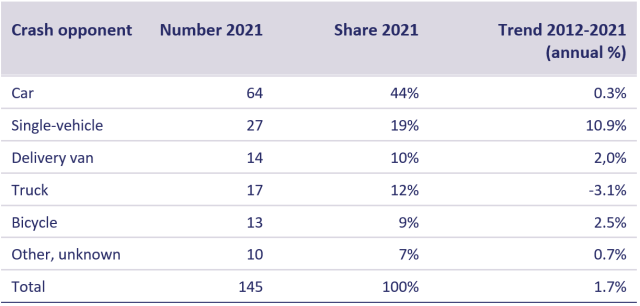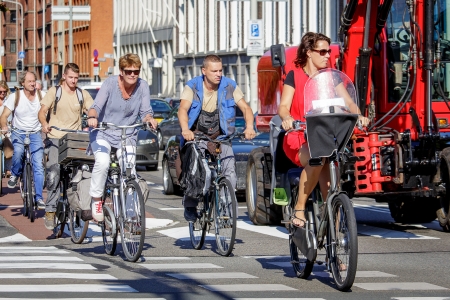Most cycling fatalities occur after a crash not involving a motor vehicle. Most seriously injured cyclists sustain injuries in crashes not involving a motor vehicle. Actual facts about bicycle crashes are scarce, because bicycle crashes in the Netherlands are very poorly registered, particularly when they concern non-fatal crashes not involving a motor vehicle [3].
Cycling fatalities
The crash registration shows that, in 2021, most (44%) cycling fatalities occurred after a crash with a car. In addition, relatively many (19%) cycling fatalities occurred in single-bicycle crashes. These are crashes not involving any other road users; they often concern falls after mounting or dismounting or crashes with objects (kerbs, bollards) etcetera. Since not every bicycle crash type is registered equally well, the number of cycling fatalities not involving motor vehicles is an underestimation.
In ten years (2012-2021), the share of road deaths on account of single-bicycle crashes significantly increased by an annual 10% (Table 1). This long-term development shows that the number of road deaths in single-bicycle crashes increased more strongly than the total number of bicycle crashes.

Table 1. The number of road deaths among cyclists by crash opponent, as registered in BRON, and long-term developments. Note: crashes not involving motor vehicles are underestimated in this table. Source: Ministry of Infrastructure and Water Management.
Almost three in five registered cycling fatalities (58%) occur in urban areas. Both in urban areas (60%) and in rural areas (55%), more than half occur at an intersection (data 2012-2021; source: Ministry of Infrastructure and Water Management).
Cycling fatalities are almost evenly spread across the days of the week, with slightly lower weekend shares (Figure 2). About half of the fatal bicycle crashes occur in the afternoon (49%) and one third (33%) in the morning (Figure 3).
Figure 2. Share of registered cycling fatalities (BRON) by day of the week (2012-2021). Source: Ministry of Infrastructure and Water Management.
Figure 3. Share of registered cycling fatalities (BRON) by part of the day ( 2012-2021). Source: Ministry of Infrastructure and Water Management.
Bicycle injuries
On the basis of the available data on serious bicycle injury crashes, a reliable breakdown by location, day of the week and time of day cannot be provided. We do know that by far most cyclists sustain serious injuries in crashes not involving a motor vehicle. In 2020, their number amounted to over 80% [2]. The injuries were mostly sustained in single-bicycle crashes, so without involvement of other road users. In a questionnaire survey among A&E-treated cyclists in the period from July 2020 to June 2021 [4] over a quarter (27%) reported that the crash had occurred in the afternoon (13.30-15.59 hours) on both week and weekend days. Yet, compared to other age groups, cyclists aged 18 to 24 relatively often reported that the crash had occurred in the evening (19.00 to 23.59 hours) or at night (00.00-05.59 hours). More than half (56%) of the A&E-treated cyclists reported that the crash had occurred in the urban area.
Abroad, cyclists also mainly sustain injuries in (single-bicycle) crashes not involving motor vehicles. An international meta-analysis [5] of single-bicycle crashes up to 2013 shows that 60%-95% of the bicycle injuries are sustained in a single-bicycle crash. A review of studies up to 2019, in mostly European countries, shows that the share of bicycle injuries caused by a single-bicycle crash varies between 52% and 85% [6].
